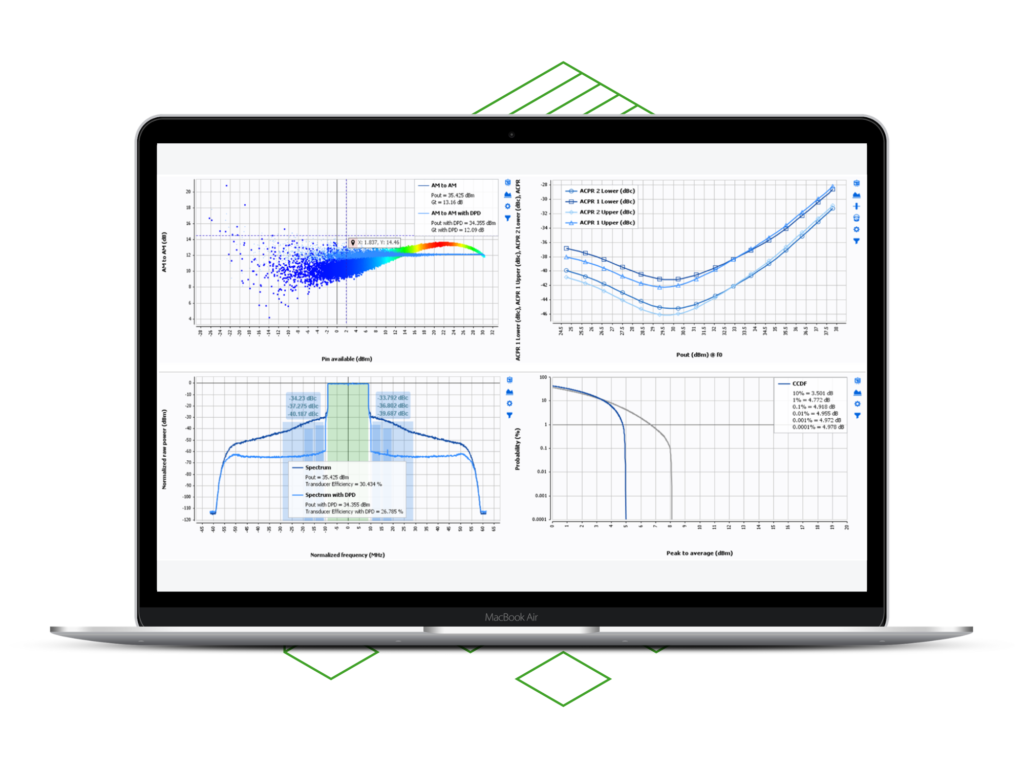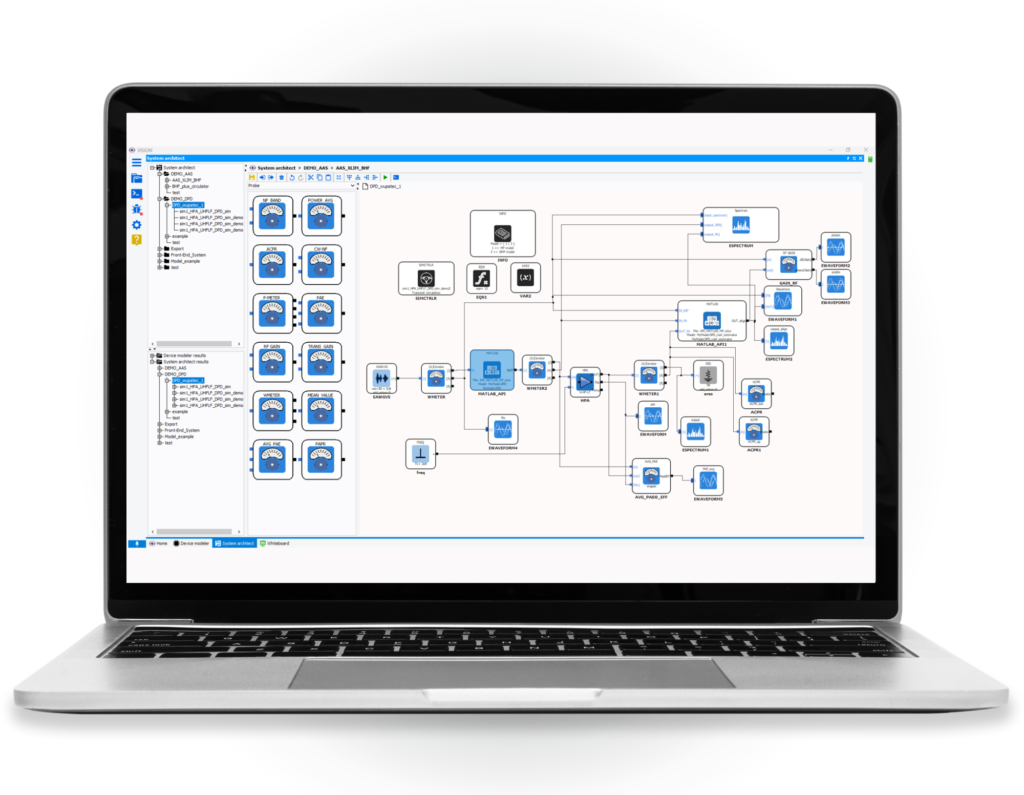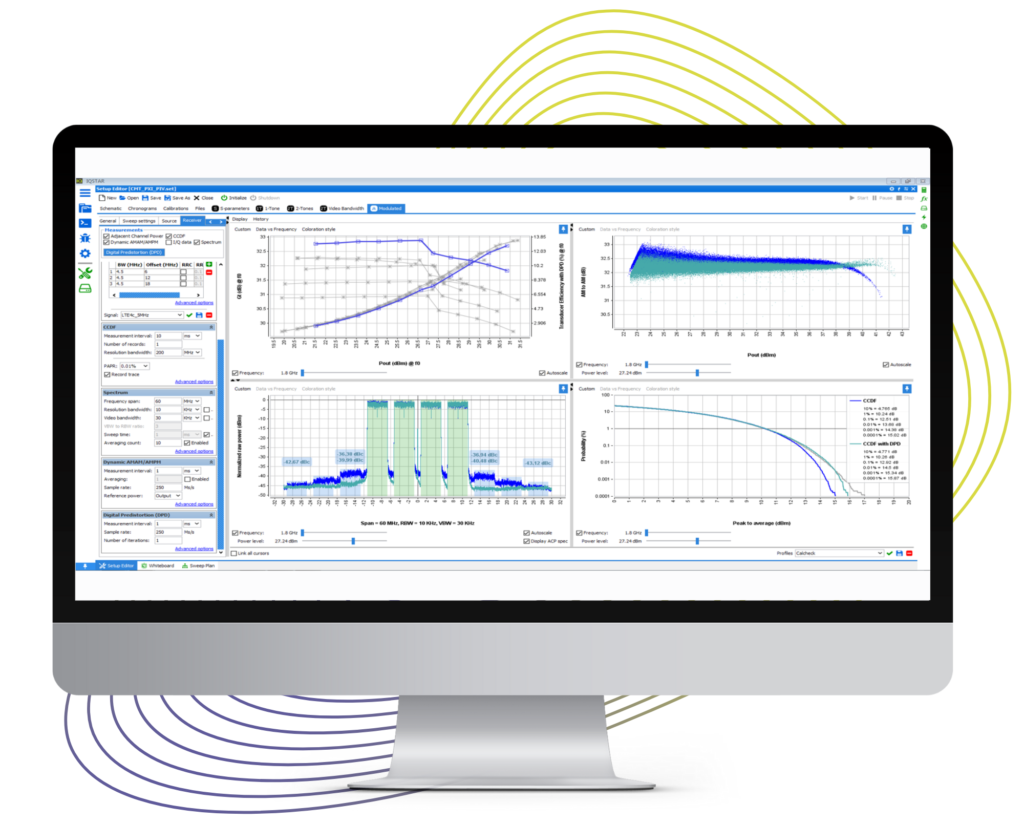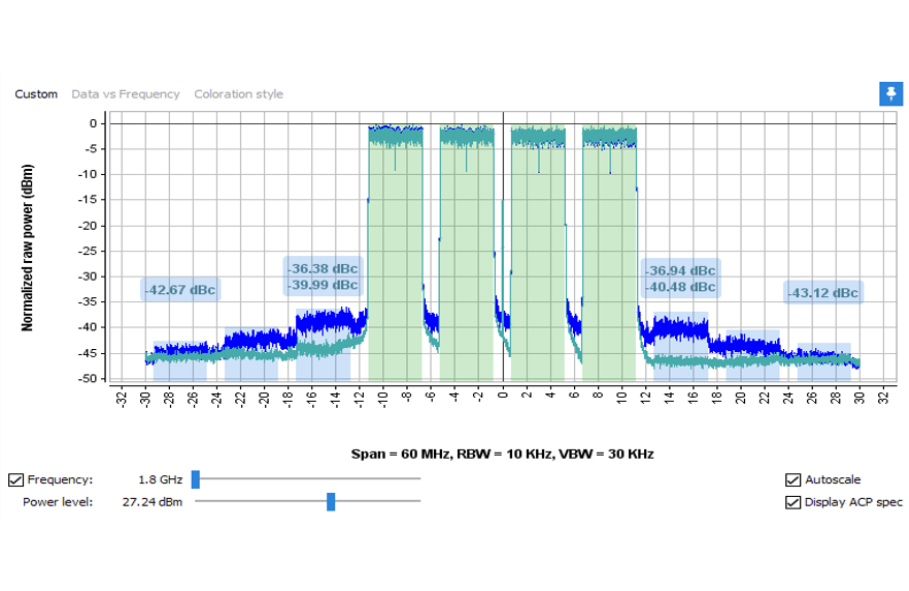Algorithms to linearize RF Power Amplifiers

Power Amplifiers are the most critical components in a communication system and are inherently nonlinear. The nonlinearity generates spectral regrowth, which leads to adjacent channel interference and violations of the out-of-band emission requirements. The nonlinearity also causes in-band distortion degrading the performance of the bit error rate (BER). It is possible to reduce the nonlinearity by backing off the power amplifier to work in the linear region. Still, this method is not viable because of the low efficiency of the power amplifier in this regime. Power amplifiers must be linearized using different techniques to enhance efficiency without compromising the linearity. IQSTAR 1.2 introduced several DPD techniques and algorithms to verify that the Power amplifier under test can be linearized with more or less complexity.
When different DPD techniques must be tested on the Power amplifier, the software must make more than one algorithm available. Starting version 1.2 of IQSTAR, a dedicated DPD module was released to respond to this request:
- Sample-based
- This technique is an iterative measurement-based method that allows achieving quasi-ideal linearization results for reference purposes. Indeed, this method is used during the verification and development phase of the PA and cannot be implemented as a real-time DPD algorithm in a transmitter.
- Memoryless (M)
- Memoryless models focus on the power amplifier with a memoryless nonlinearity: the current output depends only on the current input through a nonlinear mechanism. This instantaneous nonlinearity is usually characterized by the power amplifier’s AM/AM and AM/PM responses. The output signal amplitude and phase deviation of the power amplifier output are given as functions of the amplitude of its current input.
- Memory Polynomial (MP)
- The memory model is commonly used as the signal bandwidth gets wider and the power amplifiers exhibit memory effects, especially for high-power amplifiers used in wireless base stations. Consequently, the current output of the power amplifier depends on the current input and the past input values.
- Generalized Memory Polynomial (GMP)
- This model is built by augmenting the memory polynomial model taking into account the cross-term order. The user can set this order.
- Nanosemi Single-band Algorithm (DLL to be acquired by the customer)
- This option controls the Nanosemi single-band algorithm through a DLL and applies it externally to the measurements using instruments from different vendors. The Nanosemi DLL must be acquired separately.
- Nanosemi Dual-Band Algorithm (DLL to be acquired by the customer)
- This option controls the Nanosemi dual-band algorithm through a DLL and applies it externally to the measurements using instruments from different vendors. The Nanosemi DLL must be acquired separately.
- Matlab-based customer-developed DPD algorithm
- This option is a gateway to run a Matlab-based DPD algorithm developed by the user. This option also offers an Open-source MP algorithm that the user can adjust and optimize to his power amplifier under test. Matlab license must be acquired separately.
What do you get when using these Digital Predistortion Solutions?
With IQSTAR option IQS100B-41, the DPD algorithm can be developed by the Digital engineering team, in 3rd-party tools like Matlab for example. This algorithm is then connected to the measurement bench. This process is called “Controlling-Software-based DPD”.

With option IQS100B-40, if directly part of the measurement hardware owned by the test engineers, the “ Instrument-based DPD” algorithm of the instrument can be also activated by IQSTAR.
Questions can be asked if there are pros and cons for each techniques. This topic will be addressed in this article. Nevertheless, it is important to keep in mind that both techniques are usually part of the same DPD development workflow.
AMCAD provide different software and hardware tools, to manage at very early design stages the first steps of the DPD engineering work. System simulation works can be done before the tape-out of the RF amplifier .

AMCAD indeed provides Digital Twin Solutions. The power amplifier is replaced by an equivalent behavioral model extracted from data processing made by VISION, our modeling toolbox for advanced system simulation.
When both virtual and real platforms use the same tools (signal waveform generator, DPD algorithm, templates for data analysis), they greatly reduce the system design time cycle to accelerate the production of tomorrow’s communication systems.

Once the PA is manufactured, such an algorithm can be then applied on the circuit, to refine or validate the PA design.
There are several pros and cons to consider when comparing instrument-based digital pre-distortion (DPD) and controlling-software-based DPD
Pros of controlling-software-based DPD:
- Low cost and easy implementation. The controlling-software-based DPD can be less expensive than instrument-based systems, particularly for simple applications. Our measurement application, IQSTAR, is also offered as a no-code solution: all standard DPD algorithms are embedded in the menus, including calibration and signal alignment …
- The controlling-software-based DPD systems offer a certain degree of flexibility when customizing the pre-distortion function, which can be an advantage if you need to implement a specific one.
- This algorithm can be used with any wideband 3rd party benchtop equipment (Vector Signal Generators, Analyzers, Transceivers) or with our IQMASTER 6400 Vector Signal Transceiver
- The DPD algorithm can be easily developed in an environment like MatLab, for example, at an early stage and be connected to IQSTAR as a proof of concept for real power amplifiers. It shortens the development/test cycle.
- It can be used with any custom IPs to compensate for sharp nonlinearity or linearization of ultra-wideband signals
Cons of controlling-software-based Software DPD:
- The controlling-software-based DPD systems can be more complex to set up and operate, particularly for engineers unfamiliar with digital signal processing techniques.
- The software DPD may have much overhead time: sequencing through ethernet, waveform transfer through ethernet, pre-distorted waveform computing, and measurement time are longer.
- It offers a limited performance in terms of speed and thus cannot compensate for time-variant nonlinearity as a real-time solution.
- The slow speed also prevents the use of software DPD on very long waveforms
- Regarding its integration, the controlling-software-based DPD systems may require additional hardware and software to interface with other test and measurement equipment, which can add complexity and cost.
- This technique does not consider the limitations of FPGA implementation in real equipment. As a matter of fact, this one is not representative of computing power limitations. Pre-computed pre-distorted waveforms have no limitations, which is not the case for real-time FPGA implementation of the DPD function (model size, data precision, …)
Pros of FPGA-based DPD embedded:
- Ease of use: Instrument-based DPD systems are often designed to be user-friendly and easy to operate, making them a good choice for engineers unfamiliar with digital signal processing techniques.
- Accuracy: Instrument-based DPD systems typically offer high levels of accuracy, which can be important for applications where precision is critical.
- DPD model is applied in real-time, with no Ethernet transfers, very optimized DPD model extraction
- Very fast even with long waveforms: very effective with test model waveforms for LTE/5G. Thus, the PD can accurately compensate for time-variant nonlinearity (temperature variations…) or DC offsets.
- Representative of a real embedded system performance
- Sequencing and model extraction with an embedded ARM processor
- No need for high-performance control computers
- AMCAD provides FPGA-based DPD solutions embedded into its IQMASTER 6400 hardware solution.
Cons of FPGA-based DPD:
- The cost: Instrument-based DPD systems can be expensive, particularly for high-end systems with advanced features.
- The instrument-based DPD systems may offer limited flexibility when customizing the pre-distortion function, which can be a disadvantage if you need to implement a specific one. You cannot experiment 3rd party algorithms on the fly
- A conventional DPD model topology is generally used (the external control is limited to the default parameters: nonlinear order and memory depth)
- It requires specific expertise if a third-party algorithm has to be implemented in the FPGA
IQSTAR Options Review for DPD measurements
Open loop DPD installed on IQSTAR software-based platform is often used at an early stage for algorithm development to try the intrinsic performance of power amplifiers once linearized.
This solution can also be advantageously used with any hardware equipment (even without instrument-based DPD options) as far as minimum vector measurement capabilities are met.
Once the algorithm performance is proven, this one can be embedded into the FPGA to be aligned with end-user equipment with time-variant nonlinearity if the algorithm is compatible with the computation power of the FPGA
Consequently, software-based and FPGA-based DPD solutions must not be seen as competitive solutions but as complementary tools to optimize the linearity of power amplifiers in R&D labs.
IQSTAR supports both software and hardware-based DPD solutions

IQSTAR100B-40 is needed to test Instrument-based DPD,
If the benchtop instrument already includes DPD options, IQSTAR can take control of the equipement and leverage its measurement capabilities to drive the entire test bench connected to power sensors, DC supplies, and RF analyzers to standardize and accelerate the entire test flow.
Alternatively to high-end instruments, AMCAD also offers its IQMASTER 6400 hardware solution.
This benchtop instrument embeds RF SoCs similar to the ones which are used by telecommunication systems (i.e. base station equipment). It embeds RF transceivers and PFGA components generally used in Remote Radio Heads. Consequently, IQSTAR software is connected to our IQMASTER FPGA-based DPD platform. This is an ultimate solution to prove that RF PAs can be linearized in real application conditions. It helps PA vendors to prove that their solutions are ready for system integration.

IQSTAR 100B-41 is a software tool that supports evaluating standard and custom solutions DPD algorithms through software-based solutions , from AMCAD or Third-party applications, with different hardware brands.
It facilitates innovation and accelerates the development cycle when the algorithm developed by the digital engineering team needs to be tested on real devices manufactured by the RF engineering team fefore being implemented in FPGAs.
Having RF design teams and digital processing engineers using the same tool provides great benefits, avoiding silo effects within the same company.




